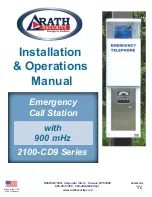
Yealink DECT Phone System Deployment Guide
13
Calculating the traffic per homogeneous area covers two aspects:
The average level of the total duration of communications per user.
The average mobility per user and per area on the site.
Up to 4 DECT handsets can simultaneously make or receive calls. This means 2 DECT
users can place calls to 2 other DECT users or 4 DECT users can place calls to 4 other
non-DECT users. When all 4 call paths are in use, no more calls can be made or received
by other handsets within the radio coverage of the base station. If the customer has an
area where more than 4 DECT users would need to make or receive calls simultaneously,
then you must install extra base stations in the area.
A ringing handset will also reserve a call path. If no call path is available, the handset
will not receive an incoming call and ring.
For optimum range and performance from your handset, follow these
recommendations:
Keep the base station/repeater away from steel constructions - at least 4 feet/1.20
meters
Do not place base station/repeater directly on metallic surfaces - at least 4
feet/1.20 meters
Do not hide base station/repeater behind furniture etc.
Do not paint the base station/repeater as paint is containing metallic/carbon
particles
The base station/repeater must be placed where the signal is needed
The following are some recommended base station and repeater placement strategies:
Around Corridors:
Base stations and repeaters should be deployed vertically preferably at corridor
intersections where propagation patterns follow the corridor patterns. In case there are
high objects in the area, the base station/repeater should be installed above those
objects.
Multi-Storey Buildings:
Base stations and repeaters can be installed on opposite sides of the floors to take
advantage of the floor-to-floor coverage. The coverage design cannot rely entirely on
floor-to-floor propagation; each case must be verified due to variations in local
Содержание Telkom W52P
Страница 1: ......

































